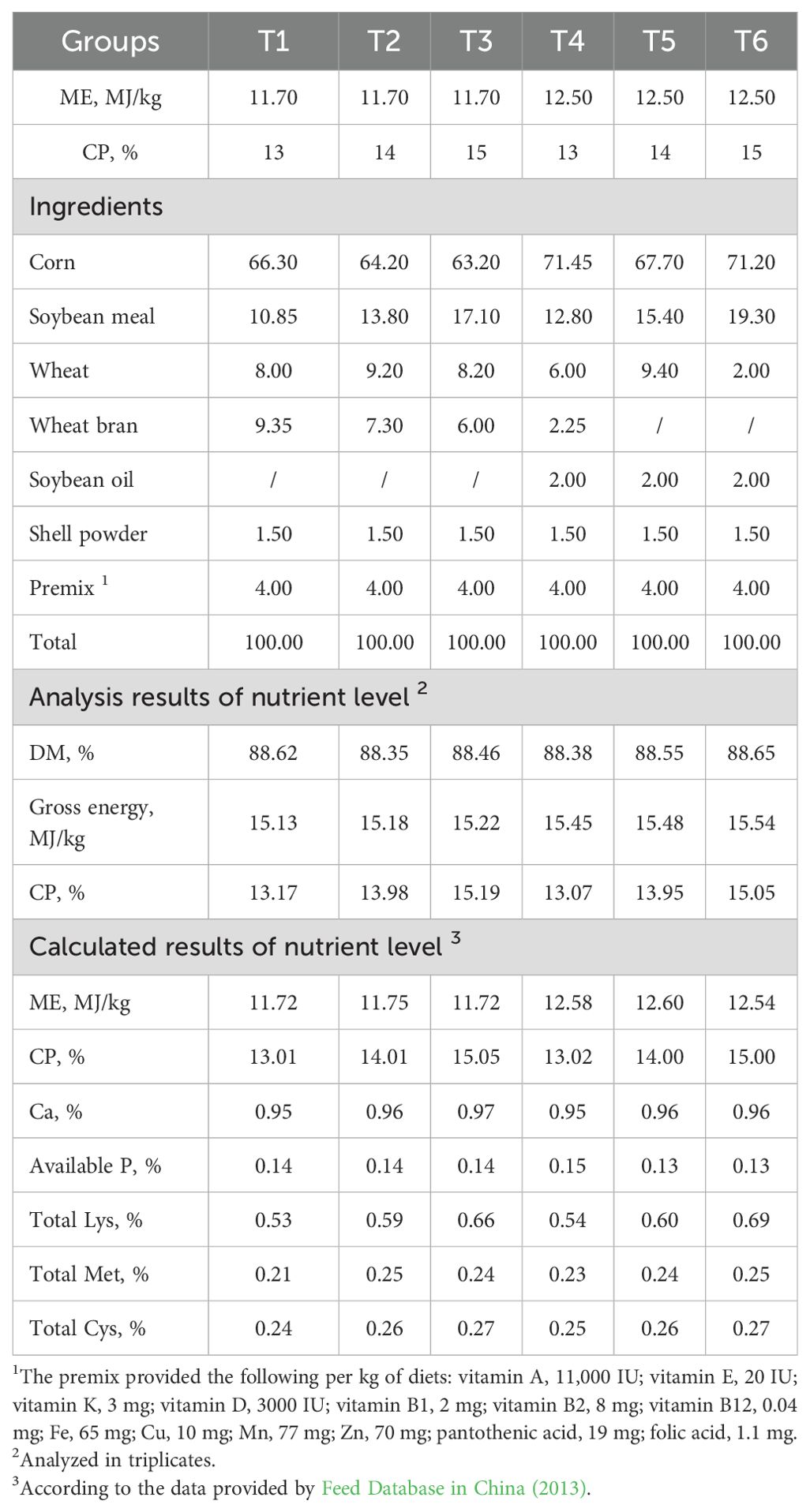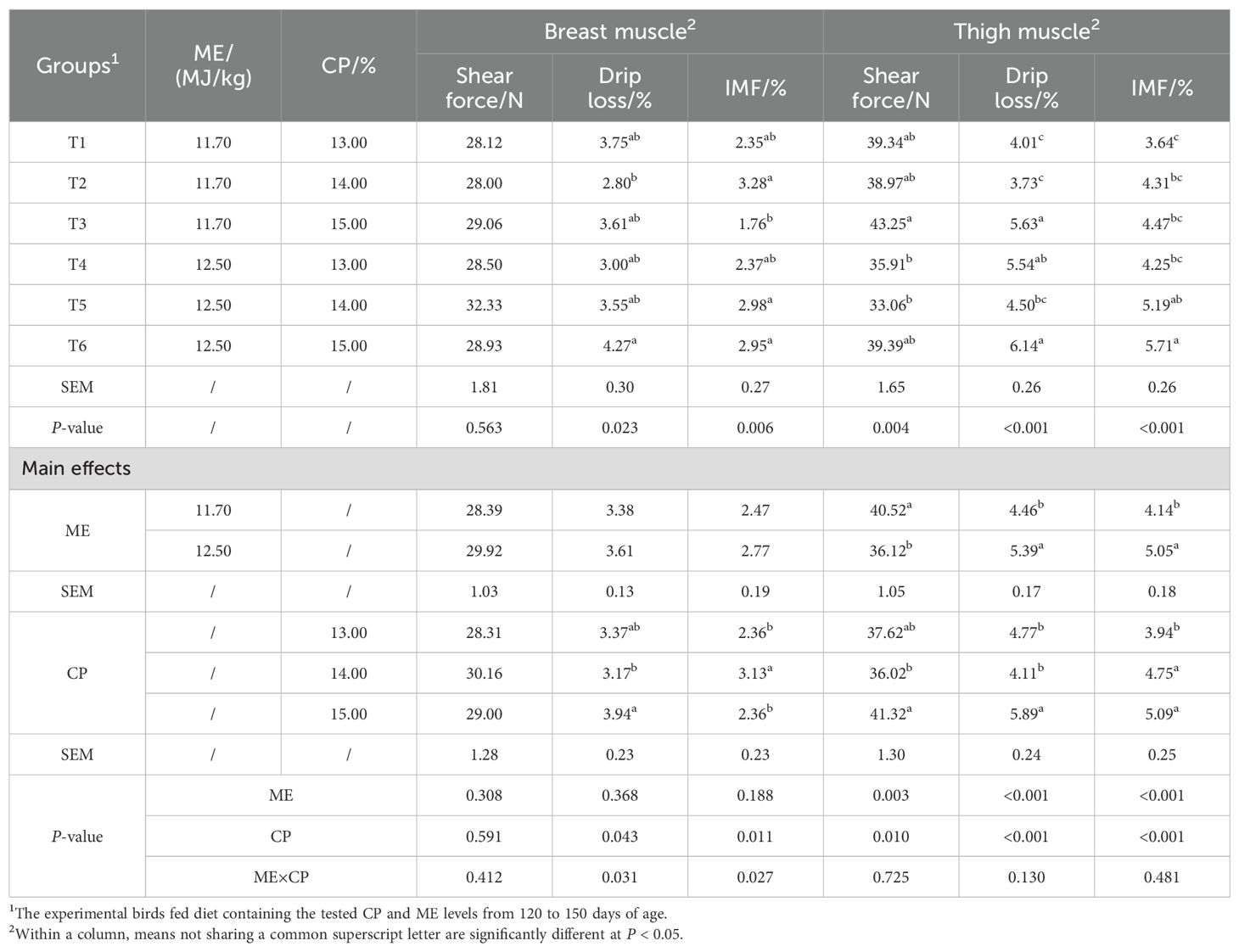- 1Tropical Crops Genetic Resources Institute, Chinese Academy of Tropical Agricultural Sciences, Haikou, China
- 2Department of Poultry Production, Faculty of Agriculture, Assiut University, Assiut, Egypt
Dietary nutrient composition is an important factor influencing the ultimate properties of poultry carcass and meat quality. This study investigated the effects of varying dietary apparent metabolizable energy (ME) and crude protein (CP) levels on the slaughter performance, meat quality, and amino acid profiles in native Danzhou chickens aged from 120 to 150 days. A total of 720 120-day-old female Danzhou chickens were randomly assigned to six experimental diets with two ME levels (11.70 and 12.50 MJ/kg ME) and three CP levels (13, 14 and 15% CP). The results showed that dietary ME and its interaction with CP had a significant impact on the semi-eviscerated carcass percentage and eviscerated carcass percentage of the chickens (P < 0.05). Irrespective of ME level, the dietary 14% CP reduced (P < 0.05) the drip loss and shear force of thigh muscle than those in the 15% CP group, increased (P < 0.05) the intramuscular fat (IMF) content in both breast and thigh muscles compared to 13% CP, and enhanced (P < 0.05) L-arginine and L-ornithine levels in breast muscle relative to both 13% and 15% CP groups. A significant interaction between dietary ME and CP levels were observed for L-threonine and L-proline content in the breast muscle, as well as for L-glutamic acid in the thigh muscle (P < 0.05). In summary, a dietary metabolizable energy level of 12.50 MJ/kg paired with a 14% crude protein content can enhance the slaughter performance and meat quality in native growing Danzhou chickens. Appropriate dietary energy and protein levels will provide a scientific support for the precise formulation of diets for Danzhou chickens in the future.
Introduction
Poultry diets should be balanced for around 38 nutrients to maintain the birds’ health and achieve the targeted performance and profit records (National Research Council, 1994). Furthermore, due to the increased consumer awareness of high-quality meat and its nutritive value, these nutrients should be optimized with regard to carcass characteristics and meat attributes (Hocquette et al., 2010). The relationship between dietary metabolizable energy (ME) and crude protein (CP) requirements has been a topic of extensive discussion for many years (Heijmans et al., 2021; Ahmadi-Sefat et al., 2022). In poultry production, appropriate levels of dietary ME and CP are essential for promoting the optimal growth and meat quality of poultry and ensuring production efficiency (Moraes et al., 2014; Mir et al., 2017; Xia et al., 2019; Musigwa et al., 2021; Chang et al., 2023). Previous studies have shown that the interaction effects of dietary ME and CP can vary depending on factors such as breed, production system, and environmental conditions (González et al., 2022; Song et al., 2022).
With the improvement of people’s living standards, there has been an increase in the consumption of high-quality meat. This has led to a growing trend of replacing fast- growing broilers with slow-growing varieties (Gou et al., 2016; Jiang et al., 2018). Danzhou chicken is a slow-growing yellow-feathered local breed, is originated in China’s Hainan province and known for its delicious meat, distinct taste, high nutritional value, and strong disease resistance (Yuan et al., 2024; Xie et al., 2024). The growth phases of Danzhou chicken as a small-sized slow-growing yellow-feathered chicken breed are broadly divided into starter (1–35 d), grower (36–120 d), and finisher (120–150 d) phase. Currently, feeding standards for Danzhou chickens are not established. In practice, their diet’s nutritional levels are usually referred to other small-sized slow-growing local yellow-feathered chickens, such as the industry - standard for nutrient requirements of yellow - feathered broilers (NY/T 3645, 2020). Generally, the dietary ME and CP requirements of chickens vary according to their growth rate and breed. In addition, the proper dietary energy and protein levels are essential for optimal growth and meat quality in livestock or poultry, as imbalances can adversely affect their production (Gous et al., 2018; Fang et al., 2019; Chang et al., 2023; Usturoi et al., 2023). Therefore, the present study aimed to determine the optimal dietary ME and CP levels for improving the carcass quality, meat quality, and composition of muscular free amino acids in growing Danzhou chickens. The findings of this study will be further refined in subsequent production and will serve as a foundation for developing future feeding standards for Danzhou chickens.
Materials and methods
Ethical statement
The Institutional Animal Care and Use Committee of the Chinese Academy of Tropical Agricultural Sciences approved all animal procedures in this study (approval number: CATAS-20221015-1).
Experimental design and chickens
A total of 720 female Danzhou chickens, all with the same average body weight at 120 days old, were randomly allocated to six treatments using a 2×3 factorial design, focusing on ME and CP as the main effects, with each treatment comprising six replicates. We designed two ME levels and three CP levels near the recommended dietary values for slow-growing yellow-feathered female broiler above 91 days old (NY/T 3645, 2020). Six diets were designed with ME levels of 11.70 or 12.50 MJ ME/kg, each paired with CP levels of 13%, 14%, or 15%, respectively. Table 1 presents the composition and nutrient levels of the diets. Some nutritional levels in the table are calculated values according to the data provided by Feed Database in China (2013). From 120 to 150 days of age, chickens were fed experimental diets in mash and housed in three-tiered wire cages (40 cm×45 cm×45 cm; two birds/cage) with ad libitum access to feed and water for 30 days. Each bird was provided by 0.1 m2 of cage floor space (10 birds/m2). The chickens were kept under a controlled lighting schedule of 18 h of light and 6 h of darkness daily. During the experimental period, the relative air humidity was around 70%, and the average room temperature was approximately 25 °C. The house was adequately ventilated using natural ventilation which was supplemented by mechanical ventilation using an exhaust fan (60 cm× 60 cm). During the experiment, mortality and cull rate were recorded across each treatment.
Sample collection
At 150 days of age, one bird per replicate was randomly selected following 12 h period of feed deprivation. The birds were immediately slaughtered via cervical dislocation. Breast muscle, thigh muscle, and abdominal fat were isolated and weighed. The relative weights of breast muscle, thigh muscle, and abdominal fat were expressed as a percentage of the eviscerated carcass weight. For each replicate, the left breast and thigh muscles from one chicken were collected and stored at 4°C for meat quality trait analysis. Additionally, approximately 2 g samples were taken from the right breast and thigh muscles and stored at - 20°C for free amino acid profile analysis.
Slaughter performance determination
Dressing percentage, semi-eviscerated, and eviscerated proportions were calculated as a percentage of the live body weight according to the Chinese standard (NY/T 823, 2020).
Meat quality determinations
The drip loss and shear force of each muscle sample were assessed using previously described methods (Zhou et al., 2022). And intramuscular fat (IMF) of muscle sample was determined by ether extraction using a Soxhlet extractor.
Free amino acid profile determination
The samples were processed and determined following the procedure described by Chen et al. (2023) with slight modifications.
The internal standard method was employed to quantify free amino acids in samples, including L-lysine (Lys), L-methionine (Met), L-tryptophan (Trp), L-threonine (Thr), L-phenylalanine (Phe), L-valine (Val), L-tyrosine (Tyr), L-proline (Pro), L-alanine (Ala), glycine (Gly), L-glutamic acid (Glu), L-aspartic acid (Asp), L-serine (Ser), L-arginine (Arg), L-histidine (His), L-citrulline (Cit), L-ornithine (Orn), 4-hydroxyproline (Hyp). Supplementary Tables S1, S2 present the MRM ion transitions for all target amino acids and the details of isotopically labelled internal standards (IS), respectively.
Statistical analysis
The experiment utilized six replicates as the experimental units. The data for each variable were checked for normality by the Shapiro-Wilk test, and those showing non-normal distribution were transformed before analysis by arcsine. A two-way ANOVA was conducted using SPSS 23.0 (IBM-SPSS Inc., Chicago, USA) to analyze the main effects and interaction between ME and CP dietary treatments. The data are expressed as means with SEM. Significant main effects identified by ANOVA were further analyzed using Tukey’s multiple comparisons test to compare the means. A P-value less than 0.05 was deemed statistically significant, while a P-value between 0.05 and 0.10 suggested a trend towards significance.
Results
Slaughter performance
During the 30-day experimental period, there were no deaths or elimination cases. Table 2 presents the impact of dietary ME and CP levels on chicken slaughter performance. It revealed a remarkably higher percentage of semi-eviscerated carcass and eviscerated carcass in the high-ME group (P < 0.05), and they were improved with the increase of CP. The high-CP group (CP level of 15%) exhibited a significantly higher dressing percentage compared to the low-CP group (P < 0.05), but there was no significant difference compared with the medium-CP group (CP level of 14%). An increase in dietary CP level was associated with a noticeable decrease in abdominal fat ratio (0.05 < P < 0.10). The combined effect of ME and CP significantly influenced the percentage of semi-eviscerated carcass, eviscerated carcass, and thigh muscle (P < 0.05). An interaction between ME and CP on abdominal fat ratio showed a trend (0.05 < P < 0.10). According to the percentage of dressing, semi-eviscerated carcass and eviscerated carcass, the optimal ME and CP levels were 12.5 MJ/kg and 15%, respectively.
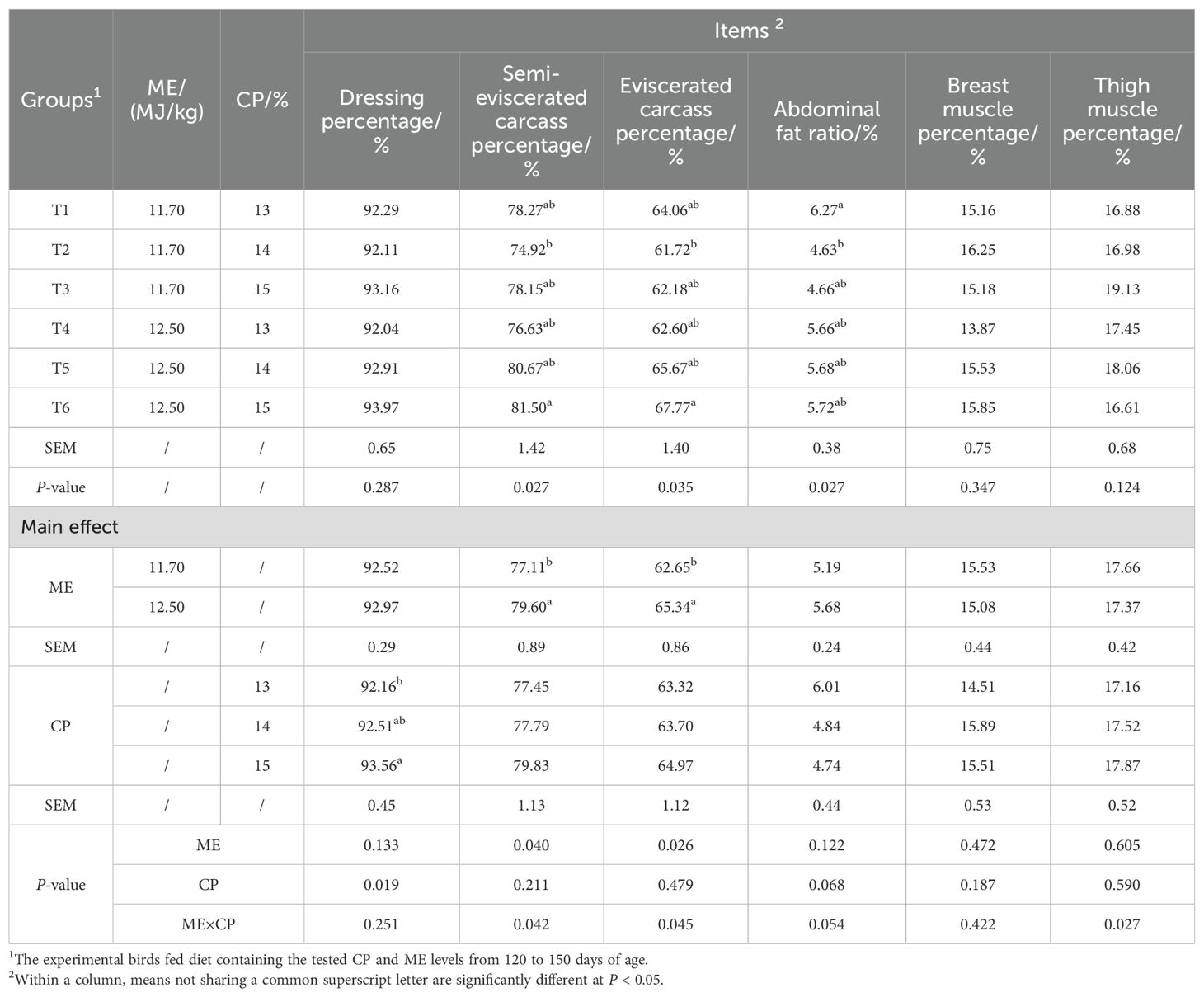
Table 2. Effect of dietary ME and CP levels on slaughter performance of Danzhou chickens aged 150 days.
Meat quality
Table 3 displays the impact of dietary ME and CP levels on the meat quality of Danzhou chickens’ breast and thigh muscles. The CP levels exhibited a significantly effect on the drip loss and IMF content in the breast muscle (P < 0.05), and the medium-CP group exhibited lower drip loss and higher IMF content (P < 0.05). Dietary ME levels exerted no significant effects on shear force, drip loss, and IMF content in breast muscles. A similar effect was observed in thigh muscles. The medium-CP group exhibited lower shear force, reduced drip loss, and higher IMF content (P < 0.05). Additionally, the high-ME group demonstrated lower shear force, higher drip loss and IMF content (P < 0.05). According to the meat quality of breast and thigh muscles, the optimal ME and CP levels were 12.5 MJ/kg and 14%, respectively.
Profile of free amino acid in muscle tissue
Table 4A reveals that the T5 group exhibited significantly higher levels of Lys, Thr, and Pro in the breast muscle compared to the T4 group (P < 0.05). The Ala content in the breast muscle was significantly lower in the T4 group compared to the T1 group (P < 0.05). The T5 group exhibited a significantly higher Orn content in the breast muscle compared to the other groups (P < 0.05). Table 4B showed that the contents of Met, Phe, Tyr, and Ala in the breast muscle increased with decreasing dietary ME level (P < 0.05). The breast muscle in the low-CP group exhibited reduced Lys content compared to the medium-CP group (P < 0.05). Additionally, Arg and Orn levels in the breast muscle was lower in both the low-CP and high-CP groups compared to the medium-CP group (P < 0.05). The interaction between dietary ME and CP significantly affected Thr and Pro (P < 0.05), and showed trend effects on Val, Ala, Glu, and Ser in breast muscle (0.05 < P < 0.10).
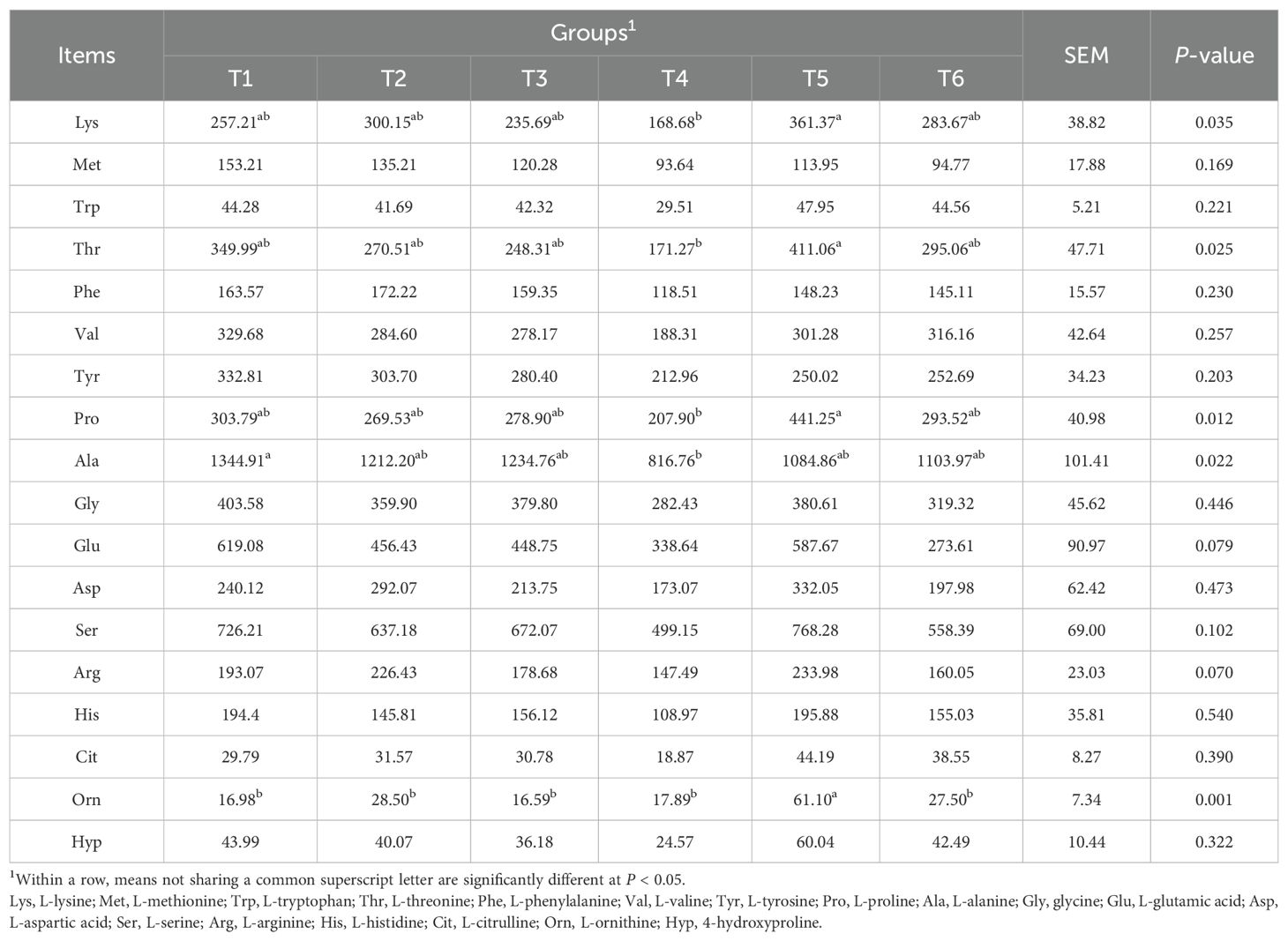
Table 4A. Effect of dietary ME and CP levels on free amino acid content in the breast muscle of Danzhou chickens (nmol/g).
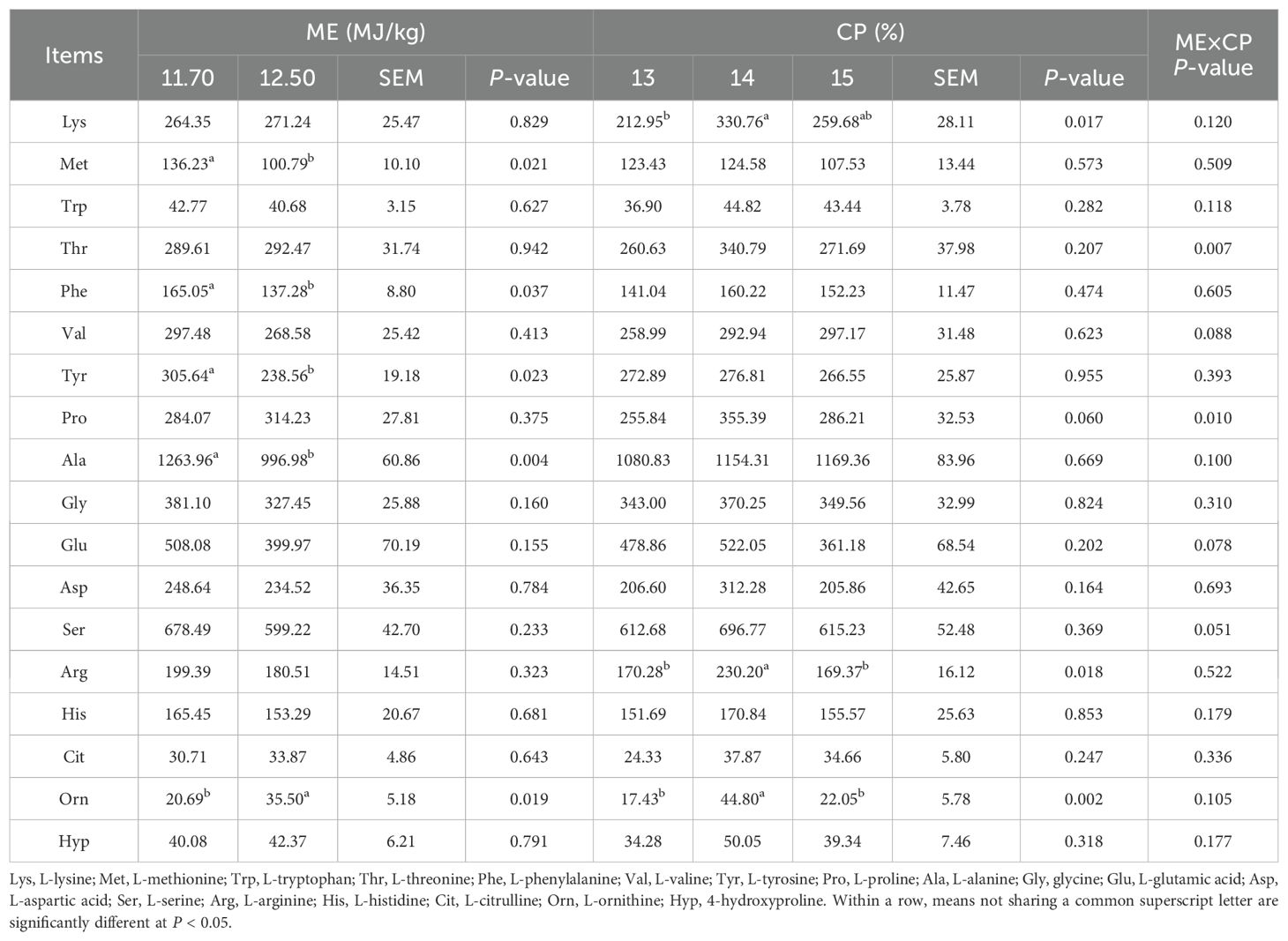
Table 4B. Effect of dietary ME and CP levels on free amino acid content in the breast muscle of Danzhou chickens (nmol/g).
As shown in Table 5A, the Hyp content of the thigh muscle was significantly higher in T5 group than in T6 group (P < 0.05). Table 5B indicated a significant increase in Ala content in the thigh muscle of the low-CP group and Gly content in the medium-CP group compared to the high-CP group (P < 0.05). The Glu content in the thigh muscle were significantly subjected to dietary ME and CP interactions (P < 0.05). A notable interaction trend between dietary ME and CP on the thigh muscle Hyp content was observed (0.05 < P < 0.10).
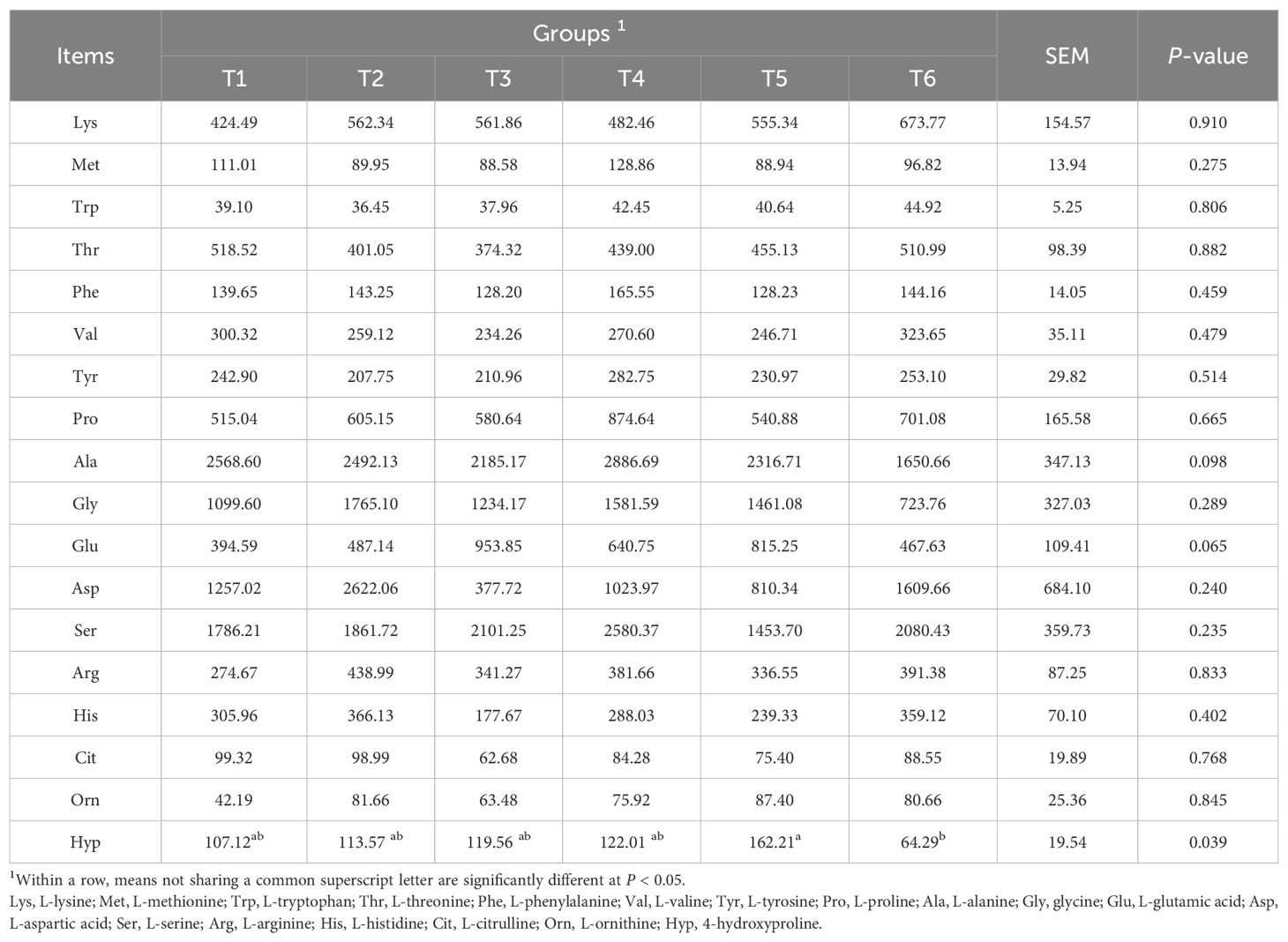
Table 5A. Effect of dietary ME and CP levels on free amino acid content in the thigh muscle of Danzhou chickens (nmol/g).
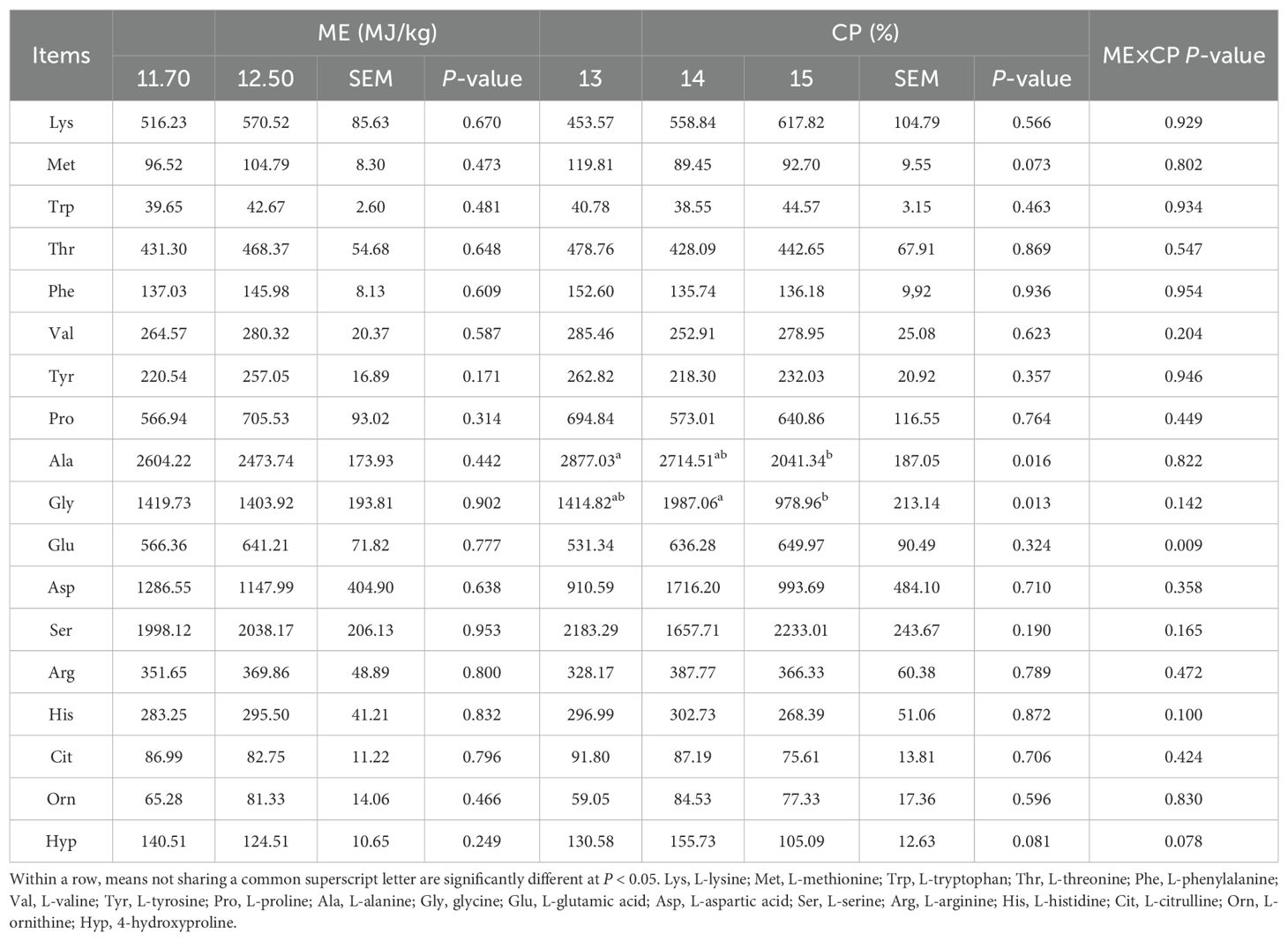
Table 5B. Effect of dietary ME and CP levels on free amino acid content in the thigh muscle of Danzhou chickens (nmol/g).
Discussion
The interaction between ME and CP significantly affected carcass characteristics, specifically the semi-eviscerated carcass and eviscerated carcass percentage. At 14% and 15% CP levels, higher ME levels enhanced both semi-eviscerated carcass and eviscerated carcass percentage, whereas at 13% CP level, increased ME levels resulted in a decrease in those percentages. A preliminary study of Waldroup et al. (1990) also indicated that a higher energy level increased dressing percentage in female chickens. Similarly, the results of Marcu et al. (2012) indicated that the carcass yield increased significantly in broiler’s females, but not males, fed high energy and protein concentrations. In addition to the obtained results, the interaction effect of ME and CP affected the thigh muscle percentage significantly. Notably, at 13% and 14% CP levels, the thigh muscle percentage increased with higher level of ME (12.5 MJ/kg), while at 15% CP level, the opposite effects were observed. Based on these findings, a dietary intake of 12.50 MJ/kg ME and 14% CP comes across as an optimal for enhancing muscle synthesis in Danzhou chickens.
Meat quality is primarily determined by factors such as IMF, drip loss, and shear force. Usually, a smaller shear force results in softer and more flavorful meat (Wen et al., 2020). It has been documented that moisture loss from drips decreases meat’s juiciness, leading to soluble flavor substances being lost from meat (Dang et al., 2022). Furthermore, the IMF content affects how juicy and tender the meat is, as well as how it tastes (Shen et al., 2015). The study indicated that dietary ME and CP levels primary affect the quality of chicken thigh muscle, while dietary CP level predominantly influences chicken breast muscle quality. The highest ME level (12.5 MJ/kg) notably reduced the shear force and enhanced IMF content in the chicken thigh muscle. This result aligns with the results of Abouelezz et al. (2019), as the tenderness of breast muscle of yellow-feathered chickens was improved by the use of high caloric diets. The reduced shear force values are often related to reduced connective tissue and increased IMF content in meat (Abouelezz et al., 2019; Abdullah and Matarneh, 2010; Koohmaraie et al., 2002). Our results show high consistency with this interpretation. The results here indicated that the medium CP level (14%), more than the low CP level (13%), contributed to increased IMF content in thigh and breast muscles. The medium CP level was more effective than the high CP level in reducing drip loss in thigh and breast muscles, decreasing shear force in thigh muscle, and increasing IMF content in breast muscle. These results might imply that high ME (12.50 MJ/kg ME) and the medium CP diets (14% CP) are suggested to be more beneficial for improving meat quality of Danzhou chickens.
Additionally, it is well recognized that the free amino acid profile of a food influences the development of specific tastes and aromas, such as sweet taste, umami taste, and bitterness (Yim et al., 2019). Prior research indicates that Ala and Gly are predominantly sweet, while Met, Phe, Tyr, and Arg are chiefly bitter (Xu et al., 2019; Islam et al., 2022). In this study, it is apparent that the amino acid profile of breast muscle was more susceptible to dietary ME level than that of thigh muscle. From the results, as compared with the high ME level, the low ME level obviously increased the contents of Met, Phe, Tyr, and Ala in breast muscle. Therefore, with the exception of Ala, three other amino acids (Met, Phe, and Tyr) accumulation within the breast muscle may allow for more bitter taste production. Besides, it has also been reported that Orn stimulates muscle tissue production and delays the effects of aging by increasing GH levels (Si et al., 2020). As essential amino acids, Lys and Arg were shown to enhance protein synthesis in the skeletal muscle and accelerate muscle growth and development (Walk and Rama Rao, 2019; Dou et al., 2023). The current study revealed that, the high ME diets or the medium CP diets increased the content of Orn in breast muscle. Meanwhile, the medium CP diets contributed to the increased accumulation of Lys and Arg in breast muscle, as well as Gly in thigh muscle. The findings indicated that a dietary ME level of 12.50 MJ/kg or a CP level of 14% can positively influence the growth, development, and taste quality of chicken muscles, particularly in the breast.
Thr and Pro are known to enhance sweetness, whereas Glu contributes to umami flavor in food (Dong et al., 2022; Wang et al., 2022). In the current study, the interaction between ME and CP level was found to be significant for both Thr and Pro in breast muscle, as well as for Glu in thigh muscle. An increase in dietary ME levels is accompanied by higher Thr and Pro contents in chicken breast muscle at dietary CP levels of 14% and 15%. Similarly, at dietary CP levels of 13% and 14%, the Glu content in chicken thigh muscle increase with rising dietary ME levels.
In conclusion, optimal dietary conditions of 12.50 MJ/kg ME and 14% CP synergistically enhanced slaughter performance, meat quality, and improved free amino acid profile in female Danzhou chickens aged 120–150 days, demonstrating their potential for application in precision feeding systems. These recommendations are for female Danzhou chicken aged 120–150 days, the requirements for other growth phases and for males are recommended for future research.
Data availability statement
The original contributions presented in the study are included in the article/Supplementary Material. Further inquiries can be directed to the corresponding author.
Ethics statement
The animal study was approved by the Institutional Animal Care and Use Committee of the Chinese Academy of Tropical Agricultural Sciences. The study was conducted in accordance with the local legislation and institutional requirements.
Author contributions
DW: Visualization, Conceptualization, Data curation, Validation, Methodology, Writing – original draft. LZ: Conceptualization, Validation, Visualization, Writing – original draft, Software. LS: Writing – review & editing, Investigation. TC: Writing – review & editing, Formal Analysis. KA: Writing – review & editing. GH: Project administration, Writing – review & editing, Funding acquisition, Resources.
Funding
The author(s) declare financial support was received for the research and/or publication of this article. This work was supported by the earmarked fund for Hainan Agriculture Research System, Hainan, China (HNARS-06-G02), and the Chinese Academy of Tropical Agricultural Sciences for Science and Technology Innovation Team of National Tropical Agricultural Science Center (CATASCXTD202407) for providing financial supports.
Conflict of interest
The authors declare that the research was conducted in the absence of any commercial or financial relationships that could be construed as a potential conflict of interest.
Generative AI statement
The author(s) declare that no Generative AI was used in the creation of this manuscript.
Any alternative text (alt text) provided alongside figures in this article has been generated by Frontiers with the support of artificial intelligence and reasonable efforts have been made to ensure accuracy, including review by the authors wherever possible. If you identify any issues, please contact us.
Publisher’s note
All claims expressed in this article are solely those of the authors and do not necessarily represent those of their affiliated organizations, or those of the publisher, the editors and the reviewers. Any product that may be evaluated in this article, or claim that may be made by its manufacturer, is not guaranteed or endorsed by the publisher.
Supplementary material
The Supplementary Material for this article can be found online at: https://www.frontiersin.org/articles/10.3389/fanim.2025.1646519/full#supplementary-material
References
Abdullah A. Y. and Matarneh S. K. (2010). Broiler performance and the effects of carcass weight, broiler sex, and postchill carcass aging duration on breast fillet quality characteristics. J. Appl. Poult. Res. 19, 46–58. doi: 10.3382/japr.2009-00079
Abouelezz K. F., Wang Y., Wang W., Lin X., Li L., Gou Z., et al. (2019). Impacts of graded levels of metabolizable energy on growth performance and carcass characteristics of slow-growing yellow-feathered male chickens. Animals 9, 461. doi: 10.3390/ani9070461
Ahmadi-Sefat A. A., Taherpour K., Ghasemi H. A., Gharaei M. A., Shirzadi H., and Rostami F. (2022). Effects of an emulsifier blend supplementation on growth performance, nutrient digestibility, intestinal morphology, and muscle fatty acid profile of broiler chickens fed with different levels of energy and protein. Poult. Sci. 101, 102145. doi: 10.1016/j.psj.2022.102145
Chang C., Zhang Q. Q., Wang H. H., Chu Q., Zhang J., Yan Z. X., et al. (2023). Dietary metabolizable energy and crude protein levels affect pectoral muscle composition and gut microbiota in native growing chickens. Poult Sci. 102 (2), 102353. doi: 10.1016/j.psj.2022.102353
Chen L., Ding H., Zhu Y., Guo Y., Tang Y., Xie K., et al. (2023). Untargeted and targeted metabolomics identify metabolite biomarkers for Salmonella enteritidis in chicken meat. Food Chem. 409, 135294. doi: 10.1016/j.foodchem.2022.135294
Dang X., Cho S., Wang H., Seok W. J., Ha J. H., and Kim I. H. (2022). Quercetin extracted from Sophora japonica flower improves growth performance, nutrient digestibility, cecal microbiota, organ indexes, and breast quality in broiler chicks. Anim. Biosci. 35, 577–586. doi: 10.5713/ab.21.0331
Dong H., Zhao X., Cai M., Gu H., Li X., Zhang Y., et al. (2022). Metabolomics analysis of Morchella sp. from different geographical origins of China using UPLC-Q-TOF-MS. Front. Nutr. 9. doi: 10.3389/fnut.2022.865531
Dou L., Sun L., Liu C., Su L., Chen X., Yang Z., et al. (2023). Effect of dietary arginine supplementation on protein synthesis, meat quality and flavor in growing lambs. Meat Sci. 204, 109291. doi: 10.1016/j.meatsci.2023.109291
Fang L. H., Jin Y. H., Do S. H., Hong J. S., Kim B. O., Han T. H., et al. (2019). Effects of dietary energy and crude protein levels on growth performance, blood profiles, and carcass traits in growing-finishing pigs. J. Anim. Sci. Technol. 61, 204. doi: 10.5187/jast.2019.61.4.204
Feed Database in China (2013). Tab les of feed composition and nutritive values in China (Beijing: Feed Database in China). Available online at: http://www.Chinafeeddata.org.cn (Accessed August 10, 2022).
González A., Navas González F. J., León Jurado J. M., Arando Arbulu A., Delgado Bermejo J. V., and Camacho Vallejo M. E. (2022). Data mining as a tool to infer chicken carcass and meat cut quality from autochthonous genotypes. Animals 12, 2702. doi: 10.3390/ani12192702
Gou Z. Y., Jiang S. Q., Jiang Z. Y., Zheng C. T., Li L., Ruan D., et al. (2016). Effects of high peanut meal with different crude protein level supplemented with amino acids on performance, carcass traits and nitrogen retention of Chinese Yellow broilers. J. Anim. Phy Anim. Nutr. 100, 657–664. doi: 10.1111/jpn.12420
Gous R. M., Faulkner A. S., and Swatson H. K. (2018). The effect of dietary energy: protein ratio, protein quality and food allocation on the efficiency of utilization of protein by broiler chickens. Brit. Poultry Sci. 59, 100–109. doi: 10.1080/00071668.2017.1390211
Heijmans J., Duijster M., Gerrits W. J. J., Kemp B., and Brand H. V. D. (2021). Impact of growth curve and dietary energy-to-protein ratio on productive performance of broiler breeders. Poult Sci. 100, 101131. doi: 10.1016/j.psj.2021.101131
Hocquette J. F., Gondret F., Baéza E., Médale F., Jurie C., and Pethick D. W. (2010). Intramuscular fat content in meat-producing animals: development, genetic and nutritional control, and identification of putative markers. Animal. 4, 303–319. doi: 10.1017/S1751731109991091
Islam M., Islam S., Fan B., Tong L., and Wang F. (2022). Influence of the degree of hydrolysis on functional properties and antioxidant activity of enzymatic soybean protein hydrolysates. Molecules 27, 6110. doi: 10.3390/molecules27186110
Jiang S., Gou Z., Li L., Lin X., and Jiang Z. (2018). Growth performance, carcass traits and meat quality of yellow-feathered broilers fed graded levels of alfalfa meal with or without wheat. Anim. Sci. J. 89, 561–569. doi: 10.1111/asj.12968
Koohmaraie M., Kent M. P., Shackelford S. D., Veiseth E., and Wheeler T. L. (2002). Meat tenderness and muscle growth: Is there any relationship? Meat Sci. 62, 345–352. doi: 10.1016/S0309-1740(02)00127-4
Marcu A., Vacaru-Opriş I., Marcu A., Nicula M., Dronca D., and Kelciov B. (2012). Effect of different levels of dietary protein and energy on the growth and slaughter performance at “Hybro PN+. broiler chickens. Pap Anim. Sci. Biotechnol. 45, 424–431. Available online at: https://www.spasb.ro/index.php/public_html/article/view/950/903.
Mir N. A., Rafiq A., Kumar F., Singh V., and Shukla V. (2017). Determinants of broiler chicken meat quality and factors affecting them: a review. J. Food Sci. Technol. 54, 2997–3009. doi: 10.1007/s13197-017-2789-z
Moraes T. G. V., Pishnamazi A., Mba E. T., Wenger I. I., Renema R. A., and Zuidhof M. J. (2014). Effect of maternal dietary energy and protein on live performance and yield dynamics of broiler progeny from young breeders. Poult. Sci. 93, 2818–2826. doi: 10.3382/ps.2014-03928
Musigwa S., Morgan N., Swick R., Cozannet P., and Wu S. B. (2021). Optimization of dietary energy utilization for poultry-a literature review. World Poult. Sci. 77, 5–27. doi: 10.1080/00439339.2020.1865117
National Research Council (1994). Nutrient requirements of poultry. 9th ed (Washington, DC: National Academies Press).
NY/T 3645-2020 (2020). Nutrient requirements of yellow chickens. Ministry of Agriculture and Rural Affairs of the People’s Republic of China (Beijing: Standards Press of China).
NY/T 823-2020 (2020). Performance terms and measurement for poultry. Ministry of Agriculture and Rural Affairs of the People’s Republic of China (Beijing: Standards Press of China).
Shen L., Luo J., Du J., Liu C., Wu X., Pu Q., et al. (2015). Transcriptome analysis of Liangshan pig muscle development at the growth curve inflection point and asymptotic stages using digital gene expression profiling. PloS One 10, e0135978. doi: 10.1371/journal.pone.0135978
Si Z., Zhou S., Shen Z., and Luan F. (2020). High-throughput metabolomics discovers metabolic biomarkers and pathways to evaluating the efficacy and exploring potential mechanisms of osthole against osteoporosis based on UPLC/Q-TOF-MS coupled with multivariate data analysis. Front. Pharmacol. 11. doi: 10.3389/fphar.2020.00741
Song B., Yan S., Li P., Li G., Gao M., Yan L., et al. (2022). Comparison and correlation analysis of immune function and gut microbiota of broiler chickens raised in double-layer cages and litter floor pens. Microbiol. Spectr. 10, e0004522. doi: 10.1128/spectrum.00045-22
Usturoi M. G., Radu-Rusu R. M., Usturoi A., Simeanu C., Doli M. G., Rau R. N., et al. (2023). Impact of different levels of crude protein on production performance and meat quality in broiler selected for slow growth. Agriculture 13, 427. doi: 10.3390/agriculture13020427
Waldroup P. W., Tidwell N. M., and Izat A. L. (1990). The effects of energy and amino-acid levels on performance and carcass quality of male and female broilers grown separately. Poult. Sci. 69, 1513–1521. doi: 10.3382/ps.0691513
Walk C. L. and Rama Rao S. V. (2019). High doses of phytase on growth performance and apparent ileal amino acid digest-ibility of broilers fed diets with graded concentrations of digestible lysine. J. Anim. Sci. 97, 698–713. doi: 10.1093/jas/sky441
Wang Q., Dong K., Wu Y., An F., Luo Z., Huang Q., et al. (2022). Exploring the formation mechanism of off-flavor of irradiated yak meat based on metabolomics. Food Chem. X. 16, 100494. doi: 10.1016/j.fochx.2022.100494
Wen Y., Liu H., Liu K., Cao H., Mao H., Dong X., et al. (2020). Analysis of the physical meat quality in partridge (Alectoris chukar) and its relationship with intramuscular fat. Poult. Sci. 99, 1225–1231. doi: 10.1016/j.psj.2019.09.009
Xia W. G., Abouelezz K. F. M., Fouad A. M., Chen W., Ruan D., Wang S., et al. (2019). Productivity, reproductive performance, and fat deposition of laying duck breeders in response to concentrations of dietary energy and protein. Poult. Sci. 98, 3729–3738. doi: 10.3382/ps/pez061
Xie X., Shi L., Zhong Z., Wang Z., Pan D., Hou G., et al. (2024). Danzhou chicken: a unique genetic resource revealed by genome-wide resequencing data. Poul Sci. 103, 103960. doi: 10.1016/j.psj.2024.103960
Xu Z., Fu L., Feng S., Yuan M., Huang Y., Liao J., et al. (2019). Chemical composition, antioxidant and antihyperglycemic activities of the wild Lactarius deliciosus from China. Molecules 24, 1357. doi: 10.3390/molecules24071357
Yim D. G., Jung J. H., Ali M. M., and Nam K. C. (2019). Comparison of physicochemical traits of dry-cured ham from purebred Berkshire and crossbred Landrace × Yorkshire × Duroc (LYD) pigs. J. Anim. Sci. Technol. 61, 35–40. doi: 10.5187/jast.2019.61.1.35
Yuan B., Asanul K. M., Rong L., Han S., Pan Y., Hou G., et al (2024). Exploring the relationship between rearing system and carcass traits of Danzhou chicken: a microbial perspective. Poult. Sci. 103 (11), 104186. doi: 10.1016/j.psj.2024.104186
Keywords: amino acid profile, carcass traits, crude protein, Danzhou chicken, metabolizable energy
Citation: Wang D, Zhou L, Shi L, Cao T, Abouelezz K and Hou G (2025) Dietary apparent metabolizable energy and crude protein levels influence slaughter performance, meat quality, and amino acid composition in slow-growing Danzhou chicken meat. Front. Anim. Sci. 6:1646519. doi: 10.3389/fanim.2025.1646519
Received: 13 June 2025; Accepted: 29 July 2025;
Published: 15 August 2025.
Edited by:
Assar Ali Shah, Jiangsu University, ChinaReviewed by:
Ravikanthreddy Poonooru, University of Missouri, United StatesSazli Tutur Risyahadi, IPB University, Indonesia
Copyright © 2025 Wang, Zhou, Shi, Cao, Abouelezz and Hou. This is an open-access article distributed under the terms of the Creative Commons Attribution License (CC BY). The use, distribution or reproduction in other forums is permitted, provided the original author(s) and the copyright owner(s) are credited and that the original publication in this journal is cited, in accordance with accepted academic practice. No use, distribution or reproduction is permitted which does not comply with these terms.
*Correspondence: Guanyu Hou, Z3Vhbnl1aG91QDEyNi5jb20=
 Dingfa Wang1
Dingfa Wang1 Liguang Shi
Liguang Shi Khaled Abouelezz
Khaled Abouelezz Guanyu Hou
Guanyu Hou